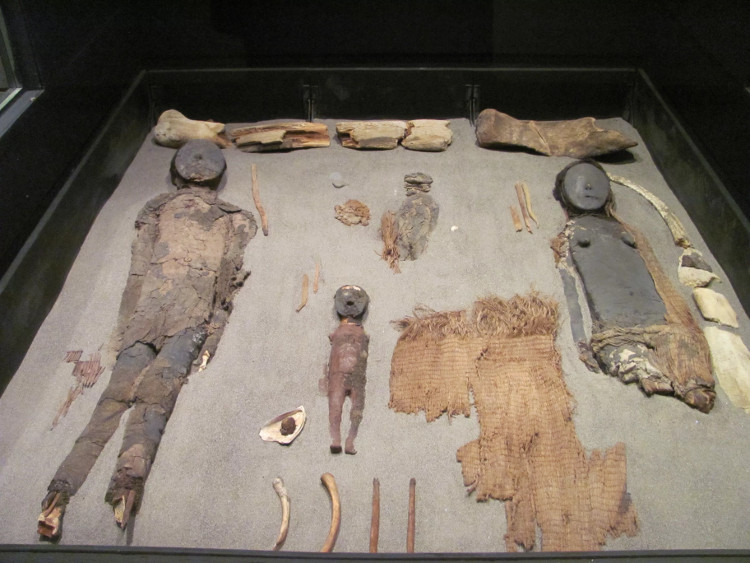Helpless researchers look at the world's oldest mummy decomposing
More than 100 found in northern Chile are gradually turning into black slime due to high humidity.
The mummies of at least 7,000 years began to turn into a black form, Science Alert reported yesterday. Last year, local authorities filed a petition with the United Nations Educational, Scientific and Cultural Organization (UNESCO), to apply for a site to excavate mummies as a world heritage.

Mummies of Chinchorro people excavated in Chile.(Photo: YouTube).
Scientists hope the move will attract the attention of the international community, helping to find a solution to treat the black slime, thought to be the result of populations of bacteria that colonize mummy skin.
"The application is not for the purpose of claiming relics, but the beginning of the process of improving conservation measures with the Chilean government and the international community" , Sergio Medina Parra, anthropologist who heads the department At the University of Tarapaca, Chile, said.
In the early 20th century, nearly 300 mummies were discovered along the coastal areas of southern Peru and northern Chile, including adult bodies, children, newborn babies and dead embryos. Some date from 5050 BC. These are the oldest mummies in the world so far.
Mummies are preserved by hunting and gathering. They embalmed the dead body before the ancient Egyptians for about 2,000 years."The date we identified from bodies was 7,000 years ago, so they are older than the mummies found in Egypt," Medina Parra said.
While the Egyptians only carried out mummification for the upper class, the Chinchorro seemed to embalm anyone, regardless of being old or young, proving that they maintained an egalitarian society."Chinchorro mummies are not limited to the upper class. This community is very democratic , " said Bernardo Arriaza, a researcher at the University of Tarapaca, who has been conducting excavations for 30 years.
Arriaza suspects poisoning drinking water from nearby volcanoes could promote the mummification process, as researchers found arsenic in mummy tissue."Arsenic poisoning can lead to high rates of miscarriage and death in newborns, and sadness in the death of loved ones can motivate this community to start preserving small bodies. Marinating. Arriaza said the body could start with the fetus and move forward to include adults .
The Chinchorro began mummifying before the Egyptians for 2,000 years.(Video: YouTube).
The reason the mummies were so intact was that they were buried under the dry sand in the Atacama desert for thousands of years, some of them here had no rain for more than 400 years. In the past century, mummies have been excavated and transferred to local research institutes for conservation.
In early 2015, the status of mummies became worse. Peruvian conservation experts must rely on the help of Harvard University scientists."We know the mummy is deteriorating but no one knows the cause. This degradation has never been studied before , " said Ralph Mitchell, a biologist at Harvard University.
Analysis of tissue samples from mummies reveals they are full of bacteria, but not ancient bacteria, but bacteria that normally live on human skin. The bacteria are accelerating the degradation process.
"As soon as conditions and humidity are met, they start using the skin as a source of nutrients. Microorganism organizations are about to eat mummies," Mitchell said.
- The oldest mummy 'mummy'
- Discover the mystery of the famous mummy
- Diagnosis of 4,000-year-old mummy
- Chile seeks support to preserve the oldest mummies in the world
- The oldest mummy in the world is threatened
- Discover the mummy mask containing the oldest Bible copy
- Successfully code the DNA of the oldest mummy in the world
- Close up of the mummy otzi mummy
- Amazingly 2 5 thousand year-old frozen mummies are still intact in Canada
- Special mummies in the world
- World famous mummies
- Discovered the oldest Egyptian mummy with chronic heart disease in the world
 Discovered an ancient centipede fossil 99 million years old
Discovered an ancient centipede fossil 99 million years old Discovered bat-like dinosaurs in China
Discovered bat-like dinosaurs in China Discovered a 200-year-old bronze cannon of the coast
Discovered a 200-year-old bronze cannon of the coast Discover 305 million-year-old spider fossils
Discover 305 million-year-old spider fossils